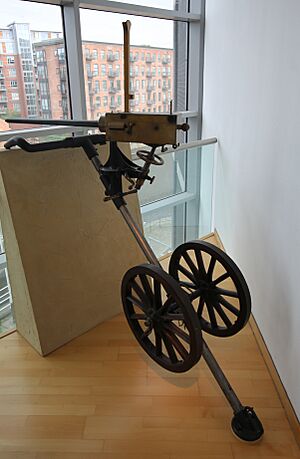Gardner gun facts for kids
The Gardner gun was an early type of machine gun that worked using a hand crank. It could have one, two, or five barrels. You would load it from a magazine or hopper at the top. When you turned the crank, a bullet (called a cartridge) would move into the back of the barrel (the breech). Then, the gun would fire. Turning the crank more would open the breech and pull out the empty shell casing.
Contents
How it was Developed
The Gardner machine gun was invented in 1874 by William Gardner. He was from Toledo, Ohio, and used to be a captain in the Union Army during the American Civil War. After making a first version, he went to the Pratt and Whitney company. They spent a year improving it to make it ready for military use.
In 1875, the gun was shown to officers at the United States Navy yard. It worked well, but they suggested more improvements to how the bullets were fed into the gun. An engineer named E. G. Parkhurst at Pratt and Whitney designed these changes. The army also saw the tests, but they weren't interested in the weapon at that time.
Parkhurst made many changes that made the gun fire more reliably. In 1877, more tests were done with a version that fired .45 calibre (11.4 mm) bullets. These tests showed that the bullets left the gun at 1,280 feet per second (390 m/s).
On June 17, 1879, another demonstration happened at the Navy Yard. Francis A. Pratt and Amos Whitney presented the gun. During this test, the gun fired a total of 10,000 rounds. This took 27 minutes and 36 seconds, including short stops to fix a small problem with one of the parts that pulled out empty casings. Even with the small issues, the gun fired 4,722 rounds before its first stop. After that, it fired about 5,000 rounds without any problems.
On January 15 and March 17, 1880, similar tests were done at Sandy Hook proving ground. This was in front of an Army review board. The gun worked well, and the board suggested the Army buy a few for testing in the field. They also noted that the gun was not expensive. However, the Army decided not to buy them.
At this point, the British Royal Navy became interested. They had already used the Gatling gun successfully. Gardner was invited to England to show his invention. The British Navy was very impressed and decided to use the gun. They also bought the rights to make it in England. Gardner stayed in England to help with building the guns.
The British Army then also became interested in machine guns. After many tests, they chose the Gardner gun. In one test, a five-barrel Gardner gun fired 16,754 rounds before it broke down, with only 24 small stops. If you didn't count mistakes made by the person operating the gun, there were only four problems in 10,000 rounds fired. The Army adopted the gun, but it took some time to introduce it because of objections from the Royal Artillery. It was used in the Mahdist War (in Sudan), especially at the Battle of Abu Klea. In the desert, the gun's parts sometimes had trouble with sand and dust.
Users
 Argentina
Argentina Austria-Hungary
Austria-Hungary Bolivia
Bolivia British Empire
British Empire Chile
Chile Denmark
Denmark Kingdom of Italy
Kingdom of Italy Netherlands
Netherlands Peru
Peru Qing Empire
Qing Empire United States
United States
Conflicts
War of The Pacific Mahdist War First Matabele War First Sino-Japanese War World War I
See also
Weapons of comparable role, performance and era
- Nordenfelt gun: a similar machine gun that also used a hand crank



